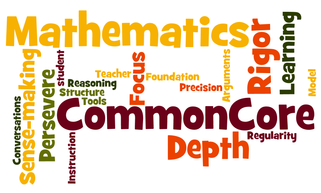I am sure you have heard and read conflicting things about Common Core. The greatest concern and the most dramatic changes are in mathematics. Here is a breakdown of the changes in the SDUHSD math program:
1. Integration – The rest of the world has always integrated math subjects. Instead of separating Geometry, Statistics, and Algebra, all topics are visited every year and spiral upward in difficulty. Just think of it as a continuation of how math is taught in elementary school. This is a positive change. Under the old curriculum, students forgot a lot of algebra topics while they were taking a year of Geometry. The first few units of Algebra 2 were spent reviewing topics that were already taught in Algebra 1. Separating the topics could be part of the reason American students score lower on international math tests than students from most other countries. The math topics have not changed, they are merely taught in a different order.
2. Critical thinking – What does this overused buzzword really mean in terms of math? In the past, students learned math by following a series of steps and by drill and practice. If all went according to plan, students would develop an automaticity which allowed them to perform mathematical tasks quickly and effortlessly. Conceptional knowledge was assumed to seep in slowly, perhaps not even at a conscious level. In the same way that reading skills, when practiced enough to allow fluency, allow the reader to free up working memory to comprehend and analyze a novel, math fluency frees up working memory to allow students to focus on higher level math skills. This method works for the majority of students, but just as some students struggle with reading fluency, many students never reach the critical thinking stages in math. This is most evident when students take Chemistry. The mathematics are basic Algebra but the application of knowledge to problem-solving is lacking.
3. Teaching conceptual knowledge and problem-solving in common core – Parents may have a harder time helping their children with their math homework. Most problems are open-ended word problems, so students who struggle with language will now struggle with math. Teachers will be more concerned with processes than with final answers. Students must learn to draw diagrams or models to show how a problem is solved. They must also use language to write about mathematical processes. This will be the greatest shift and greatest challenge to most students. This approach to math is radically different from the methodology used in Asian countries that outperform Americans every year in math.
4. The role of drill and practice – It is difficult to imagine that learning the concepts behind the math will hurt students, however, it may if it replaces the standard drill and practice. Implementation of Common Core math will vary from teacher to teacher. In my son’s 6th grade class, drill and practice is almost non-existent. He is assigned 2-3 math problems for homework which require drawing elaborate models. The teacher guide to the adopted curriculum suggests that each problem takes up to 8 minutes! This leaves very little time for drill and practice. They also seem to shy away from using formulas. Plugging in numbers to a formula, apparently, is lacking in critical thinking. Without drill and practice, students will never gain the fluency and automaticity that give students the ability to perform higher level functions. The human brain’s greatest weakness is its limited capacity for working memory. That is why formulas help us to calculate quickly and effortlessly.
5. The bottom line – Each student learns differently. There is no one method of teaching math that works for everyone. Maturation is the most important component of critical thinking during adolescence. Physical maturation is easy to observe – students growing beards next to boys with high voices – yet brain maturation is even more profound. Not all students are ready for higher level problem solving at the same time. The solution offered by the district is to put those students into Readiness classes. However, as a parent, you don’t need a researcher to tell you how kids begin to think of themselves when they are assigned to remedial classes. How a student perceives himself as a math student is very important to future success. Too many students settle into a comfortable pattern of believing they aren’t good at math. This is detrimental to motivation and success.
6. What can a parent do to help? In addition to helping with homework to reduce frustration, make sure your child is doing enough drill and practice. There are many great websites designed just for this. Your child’s school probably pays for subscriptions for some of these programs, so begin by asking the teacher for suggestions. Look for links on the class website. Others are free and parents can opt to pay $5-$10 per month for added features. For grades K-6, I like AdaptedMind.com and for middle and high school IXL.com works well. There are many others that are just as good, so after a student gets bored with one website, switch to another. Khan Academy is another great choice. Motivate your child with rewards and after a while, success in school will be its own reward. By getting ahead in math, your child will begin to think of himself as “good at math” which will promote motivation and perseverance. Your child won’t give up so easily and will have the fortitude to try a different method if he doesn’t get it right the first time.





 High Bluff Academy
High Bluff Academy